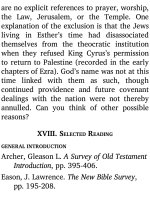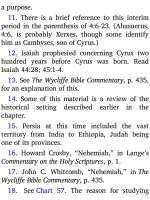Jensens survey of the old testament adam 542
Bạn đang xem bản rút gọn của tài liệu. Xem và tải ngay bản đầy đủ của tài liệu tại đây (171.9 KB, 4 trang )
that you have established in your own
personal study. Use the suggestions given
below to send you on various paths of
inquiry.
1.
Identify
the
introduction
and
conclusion of the letter. What does Paul
write about in each part, in addition to the
customary greetings?
2. Regard each chapter (not including the
introduction and conclusion) as a unit of
study. Read the chapters a few times and
observe the things Paul writes about and
how he writes them.
3. Note the two comprehensive doctrinal
passages cited earlier (2:11-14 and 3:4-7).
What is the context of each? What is the
content of each?
4. You will observe the word doctrine as
one of the key words of Titus. Note the
phrase of 2:10, “that they may adorn the
doctrine of God our Savior in every respect.”
The meaning of “adorn” is “to make
attractive” (cf. NIV translation). As you read
the text of Titus, observe the many ways
Paul exhorts to good deeds, which are the
adornment of the gospel. Note the repetition
of the phrase “good deeds.”
5. What groups of people does Paul write
about in each chapter?
B. SURVEY CHART
Study carefully the di erent structural
outlines shown on the survey, Chart 99, and
note the following:
1. In this letter Paul writes mainly about
three groups: leaders, opponents, and
followers. Survey the Bible text to identify
who they are.
CHART 99: TITUS: ADORNING THE
DOCTRINE OF GOD
2. Note the outline centered on doctrine.
How is this outline derived from the Bible
text?
3. Note the other outlines appearing on
the chart. Relate these to your own
observations in the survey process.
4. What title is assigned to the letter?
What verse is it derived from?
XII. PROMINENT SUBJECTS OF TITUS
A. FALSE TEACHING IN A CHURCH (1:116)
After an inspiring greeting (1:1-4), Paul
launches into the main subject of his letter
without delay. The churches of Crete had
some glaring defects, and the apostle
wanted Titus to “set things in order” there
(1:5).
This rst chapter illustrates a consistent
principle of the Bible: no diagnosis without
prescription for cure. As far as Paul was
concerned, the problems of the churches on
the island of Crete could be solved, hence
the letter to his friend and co-worker.
Read the chapter again and observe these
three parts:
1.
Doctrine (1:1-4). False teaching is best
dealt with by true doctrine. What
di erent doctrines does Paul refer to









